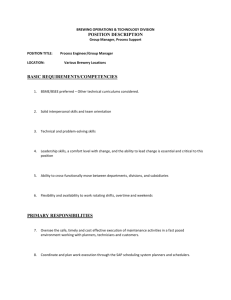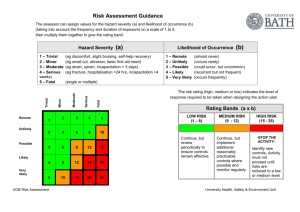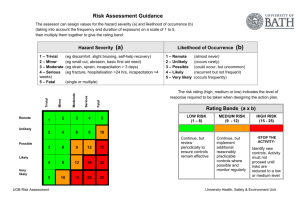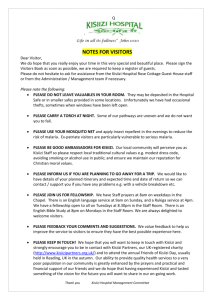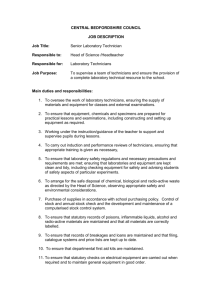Risk Assessment Guidance
advertisement
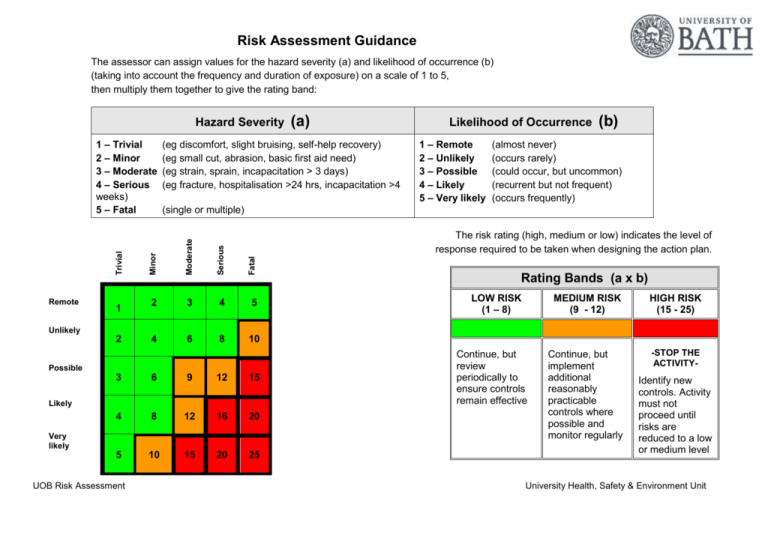
Risk Assessment Guidance The assessor can assign values for the hazard severity (a) and likelihood of occurrence (b) (taking into account the frequency and duration of exposure) on a scale of 1 to 5, then multiply them together to give the rating band: Hazard Severity 1 – Remote 2 – Unlikely 3 – Possible 4 – Likely 5 – Very likely (b) (almost never) (occurs rarely) (could occur, but uncommon) (recurrent but not frequent) (occurs frequently) Fatal The risk rating (high, medium or low) indicates the level of response required to be taken when designing the action plan. Serious 1 Likelihood of Occurrence (single or multiple) Moderate Remote (eg discomfort, slight bruising, self-help recovery) (eg small cut, abrasion, basic first aid need) (eg strain, sprain, incapacitation > 3 days) (eg fracture, hospitalisation >24 hrs, incapacitation >4 Minor Trivial 1 – Trivial 2 – Minor 3 – Moderate 4 – Serious weeks) 5 – Fatal (a) 2 3 4 5 4 6 8 10 Rating Bands (a x b) LOW RISK (1 – 8) MEDIUM RISK (9 - 12) HIGH RISK (15 - 25) Continue, but implement additional reasonably practicable controls where possible and monitor regularly -STOP THE ACTIVITY- Unlikely 2 Possible 3 6 9 12 15 4 8 12 16 20 5 10 15 20 25 Likely Very likely UOB Risk Assessment Continue, but review periodically to ensure controls remain effective Identify new controls. Activity must not proceed until risks are reduced to a low or medium level University Health, Safety & Environment Unit Risk Assessment Record Risk Assessment of: Name Overview of activity / location / equipment / conditions being assessed: Assessor(s): Date: Graham Mott (Technical Manager and Dept Safety Coordinator) Preparation of lime mortar samples using a paddle mixer and prism moulds. Testing of compressive & flexural strength, vapour permeability & thermal conductivity. Generic or specific assessment? Specific Context of assessment planning stage / in consultation with employees / in consultation with managers / # Hazard(s) identified Persons affected Existing controls & measures 1 Risk of electrocution from electrical equipment used near water. Technicians, Postgrad, Undergrad, visitors Trip/slip hazard Technicians, Postgrad, Undergrad, visitors Crush injury from heavy objects Technicians, Postgrad, Undergrad, visitors 2 3 UOB Risk Assessment A B AxB Additional controls required Cables and sockets are positioned tidily away from wet areas. RCD's on critical equipment,. water resistant cases/covers for electrical control boxes. Laboratory is kept tidy with any trailing leads covered. Spillages are cleared up immediately Anyone working in labs to wear safety footwear, including adequate toe protection. University Health, Safety & Environment Unit # Hazard(s) identified Persons affected Existing controls & measures 4 Damage to respiratory tract and lungs from lime inhalation Technicians, Postgrad, Undergrad, visitors 5 Skin damage, in form of burns/dermatitis, from contact with lime Technicians, Postgrad, Undergrad, visitors 6 Eye damage or irritation from contact of lime with eyes. Technicians, Postgrad, Undergrad, visitors 7 Damage to respiratory tract and lungs from inhalation of nano particles Technicians, Postgrad, Undergrad, visitors 8 Absorption of nano particles through the skin Technicians, Postgrad, Undergrad, visitors 9 Eye damage or irritation from contact with nano particles Technicians, Postgrad, Undergrad, visitors UOB Risk Assessment Carry out dust-generating activities under extractor in room 1.19 whenever possible. Wear a dust mask Cover all exposed skin when handling lime, using PPE i.e. gloves, boiler suit. Wear eye protection (goggles) when handling/mixing anything containing lime. Carry out dust-generating activities under extractor in room 1.19 whenever possible. Wear a dust mask Whenever possible, carry out work in a chemical fume hood. Lab coat must be worn Gloves must be worn to cover the wrist and any skin not covered by the lab coat Safety glasses/goggles must be worn A B AxB Additional controls required Ensure access to lab area is restricted where mixing/ dust inducing activities are taking place. If lime inhalation occurs, remove affected person to fresh air and if continues occurs seek medical attention. If lime comes in contact with skin, irrigate skin with plenty of water. If eyes come into contact with lime, move immediately to nearest eyewash station and irrigate eye thoroughly. University Health, Safety & Environment Unit # Persons affected Hazard(s) identified 10 Injury from moving parts when working Technicians, Postgrad, with machinery Undergrad, visitors Assessor signature: Existing controls & measures A B AxB Additional controls required No trailing clothing to be worn Keep distance from working machinery Print name: Review date: Risk Assessment Action Plan Action Plan in respect of: Ref no. Prepared by: Action to be taken, incl. Cost Responsible manager’s signature: Print name: UOB Risk Assessment By whom Target date Review date Outcome at review date Responsible manager’s signature: Date: Print name: Date University Health, Safety & Environment Unit
